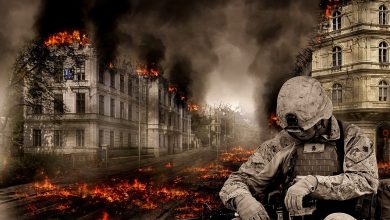The war in Ukraine: NATO monitors Russian ‘zombies’ in Estonia
Challenger 2 main battle tanks, multiple launch missile systems, Wildcat and Apache helicopters and even a company of French Foreign Legionnaires are designed to deter Moscow
The team’s cramped room, in a building right next to the runway at Amari Air Base in Estonia, is playing old episodes of Friends on the TV.
Feet up on the table, coffee mug in hand, casual banter filling the room. On the TV screen, Rachel has just returned from the hairdresser and Ross is upset about something. Then an airman pokes his head through the door and calmly announces, “One of their zombies is moving north from Kaliningrad.”
Ukraine war: Nato watches Russian 'Zombies' in Estonia https://t.co/MllAS9ui0c
— BBC News (World) (@BBCWorld) May 23, 2023
People instantly get up and go to the adjacent operations room, where screens and digital maps are marked “NATO Secret” and flicker constantly because of the streams of incoming data.
This is the Operation Azotize Rapid Reaction Force, a NATO air policing mission in the Baltic Sea that guards the alliance’s northeastern borders, where Russian planes regularly probe the borders of NATO territory, the Air Force revealed in its report.
In April, the RAF’s 9th Typhoon Fighter Squadron took over command of the mission from the German squadron with the historical name Richthofen.
Russia’s full-scale invasion of Ukraine has forced the NATO military alliance to focus its efforts on securing its eastern borders. The goal is simple: to prevent Russia from invading anywhere else, and in particular in NATO countries – such as one of the three Baltic states or Poland.
The NATO Parliamentary Assembly adopted a declaration in which it called on the governments and parliaments of the member countries of the North Atlantic Alliance to speed up the provision of military equipment urgently needed by Ukraine, in particular, fighter jets#UkraineWar pic.twitter.com/wosOM8g3h1
— UATV English (@UATV_en) May 23, 2023
“Zombie” is code for a Russian plane with suspicious activity.
“It usually means one of these three things,” explains McCall of RAF Lossiemouth in Scotland. “Either he didn’t file a flight plan, or they don’t have communication, or they just don’t respond to air traffic control. Sometimes it’s all three.’
In this case, it turns out to be a false alarm as the zombie turns north and away from NATO borders.
Estonia’s Amari airbase, where the Typhoons are based, was a Cold War target for the Soviet air force, and in the nearby forest, there is still a cemetery where Soviet pilots are buried along with the tails of their old MiG-15s and MiG-17s.
There were 13k MiG-15s, 10k MiG-17s, 2k MiG-19s, 11k MiG-21s, 5k MiG-23s and 1k MiG-27s. That's a lot of MiGs before the Su-27! For decades, Sukhoi and the others made up only a tiny fraction of the Soviet fighter force. https://t.co/WIj2X3nk2q
— Tempest Books (@tempest_books) April 4, 2023
Today, the mission of NATO pilots is both complex and ruthless. After Finland joined NATO, the Baltic Sea borders seven members of the Western alliance, soon to be eight when Sweden is added.
But Russia still has two strategic points in the Baltic Sea: St. Petersburg to the east and its exclave of Kaliningrad, the former Prussian city of Königsberg, and its hinterland, a place now full of missiles and other military hardware.
Russian Su-27 flanker fighters, airborne command and control aircraft, and cargo planes fly continuously over the Baltic Sea between these two bases and beyond, keeping NATO air forces on constant alert.
“So we can be sitting with our feet up on the table, drinking a cup of hot coffee, and the next second the alarm goes off,” said one of the younger Typhoon pilots, who spoke on condition of anonymity.
“We respond to every alarm as a real threat. So we run to the plane, put on our gear, start the engines, fasten our seat belts, talk to the control tower, talk to radio operations, get clearance, and then take off and get in the air as fast as we can.”
Russia's envoy to the US said that providing F-16 jets to Kyiv would raise the question of NATO’s involvement in the Ukraine war.https://t.co/uSYeT816KH
— DW News (@dwnews) May 22, 2023
Inside the hangars, another pilot approaches one of the Typhoons. They are armed and “ready” to go into battle if necessary.
Leakes points to a long, sleek rocket: “This is the Meteor,” he says. “It has been in service since 2018. It has its own radar homing head at the front end and its own road jet propulsion at the rear.”
Other, smaller missiles designed for shorter-range engagements stand menacingly on the wingtips.
So what actually happens when the pilots get close to these Russian zombies? No one is supposed to start firing missiles and start World War III.
“Our role here is to protect NATO airspace,” McCall replies, adding cryptically “our operating rules are classified information.”
The Ministry of Defense of the United States of America has confirmed that thirty-one M1 Abrams tanks have arrived in Germany for the training of the Ukrainian military, the spokesman of the department, Patrick Ryder, said at a briefing, writes CNN.#UkraineWar #ukraine pic.twitter.com/K5VOPFTraq
— NewsUkrainian24 (@NewsUkrainian24) May 15, 2023
Another pilot is a bit more forthcoming and adds: “We don’t know what plane we’re going to run into and intercept. So we go up to it, we identify it, and then we get additional guidance, additional missions from the Operations Center and respond to what they tell us to do.”
What we do know is that the RAF pilots took lots of pictures of the zombies as they approached them and escorted them through NATO airspace.
“We conducted eight interceptor missions,” McCall says. “Everybody has been against the Russian planes… We’ve been doing air policing in the Baltics for a few years now, but no doubt Russia’s illegal invasion of Ukraine last year changed the dynamic here.”
Things have also changed in a place where there is now a need to deploy ground forces to deter any future Russian invasion.
Fact of the Day: The F15 will sniff the rear of other aircraft (Seen here sniff testing a WildCat helicopter) to decide if they are friendly or a baddie. Pilots of all aircraft will often do the same to anyone they come into contact with.
Photographed from a Canberra #AvGeek pic.twitter.com/KD9Pdq7JRz
— RAF_Luton (@RAF_Luton) September 5, 2022
Estonian Prime Minister Kaia Kalas, who grew up as a child in the Soviet Union, said she has no doubt that if President Putin’s invasion of Ukraine ultimately succeeds, it will only be a matter of time before he turns his attention to the Baltic states.
As part of NATO’s “enhanced presence” policy in these Baltic states and Poland, there is a British-led multinational battle group based in Tapa, northern Estonia. Challenger 2 main battle tanks, multiple launch missile systems, Wildcat and Apache helicopters, and even a company of French Foreign Legionnaires are intended to act as deterrents against any action by Moscow.
⚡️What do you think the top combination Tank+BMP+Howitzer armed with 🇺🇦AFU will be the most effective in a counterattack against the 🇷🇺RF ?
1.🇺🇸 M1A1 Abrams+M2 Bradley+ M109A6 Paladin
2.🇩🇪 Leopard 2А6+Marder+RCH 155
3.🇸🇪Strv 122+CV-90+Archer
4. 🇬🇧🇫🇷Challenger 2+AMX-10 RC+AS-90 pic.twitter.com/dIEOX2BuXf— 🇺🇦Ukrainian Front (@front_ukrainian) May 18, 2023
“The challenge for NATO here in the Baltics,” says Brigadier Giles Harris, who commands Operation Cabrit, Britain’s contribution to Estonia, “is to deter Russia without escalating the situation.”
However, their numbers are small compared to the huge forces that Russia can muster across the border. There is a grudging acknowledgment that NATO deterrence forces stationed in Estonia will act as reinforcements as Russian forces advance west.
Does NATO have enough forces?
“Battlegroups in the Baltics should be a sufficient deterrent,” says Brig Harris. “However, if that fails, then we are done. If Russia invades, then we go east to fight them.”



